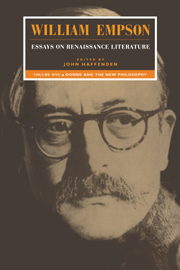Book contents
- Frontmatter
- Contents
- Preface
- Sources and acknowledgements
- Introduction by John Haffenden
- 1 Donne and the rhetorical tradition
- 2 Donne the space man
- 3 Donne in the new edition
- 4 Rescuing Donne
- 5 Donne's foresight
- 6 Copernicanism and the censor
- 7 Thomas Digges his infinite universe
- 8 Godwin's voyage to the moon
- Appendix on Galileo
- Notes
- Index
6 - Copernicanism and the censor
Published online by Cambridge University Press: 01 February 2010
- Frontmatter
- Contents
- Preface
- Sources and acknowledgements
- Introduction by John Haffenden
- 1 Donne and the rhetorical tradition
- 2 Donne the space man
- 3 Donne in the new edition
- 4 Rescuing Donne
- 5 Donne's foresight
- 6 Copernicanism and the censor
- 7 Thomas Digges his infinite universe
- 8 Godwin's voyage to the moon
- Appendix on Galileo
- Notes
- Index
Summary
It has been pronounced that there was no censoring of the Copernican Theory under the first Elizabeth, and indeed, no book was suppressed which later became known; but this does not go very far. All books had to be licensed before they could be printed, at least in principle, and a book arguing for an unwelcome belief could be suppressed without any evidence surviving. One cannot prove that the system was never used, and the mere possibility would often prevent a man from writing such a book. Thomas Harriot is reproached in a letter from a friend [Sir William Lower], for losing his priority in a discovery, yet again, by refusing to print it; and still he would not print anything at all. Perhaps he was hoping for better conditions in the next reign; but after five years under James he wrote despairingly to Kepler [13 July 1608, Old Style]:
Things with us are in such a condition that I still cannot philosophize freely. We are still stuck in the mud. I hope almighty God will soon put an end to it.
He had been accused of atheism rather wildly in pamphlets, as part of a political campaign against Ralegh, and suffered a brief imprisonment at the start of the inquiry, and when he wrote had long been acting as agent for Ralegh and Northumberland, who were in the Tower; it may be argued that he was in no real danger, and his troubles had made him neurotic or petulant.
- Type
- Chapter
- Information
- William Empson: Essays on Renaissance Literature , pp. 207 - 215Publisher: Cambridge University PressPrint publication year: 1993



